|
|
Our Holy Father Sisoes the Great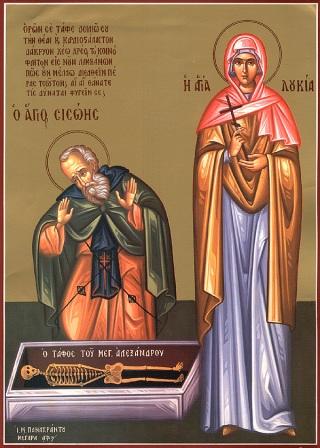 An Egyptian by birth, he lived at first in Scetis then, after St Antony"s death, settled on the desert mountain on which Antony had earlier lived in asceticism and which was named after him. He learned humility through great struggles with himself, becoming meek and guileless as a lamb. Therefore God gave him the great gifts of healing the sick, driving out unclean spirits and raising the dead. Sisoes lived in the desert for sixty years, and was a fount of living wisdom for all the monks and lay folk who came to him for advice. At the time of his death, his face shone like the sun. The monks stood around him and marvelled at this sight and, when the saint gave up his soul, the whole chamber was filled with a wonderful fragrance. He entered into rest in great old age, in about 429. St Sisoes taught his monks: "When temptation comes to a man, that man must give himself over to the will of God, and acknowledge that the temptation comes upon him because of his sins. If something good comes to pass, he must acknowledge that it comes about by the providence of God." A monk asked him: "How can I please God and be saved?" The saint replied: "If you desire to please God, withdraw from the world, separate yourself from the earth, leave aside creation and draw near to the Creator, unite yourself to God with prayers and tears, and you will find rest in this world and in the next." A monk asked Sisoes: "How can I acquire humility?" The saint replied: "When a man learns to regard every man as better than himself, he thus acquires humility." Ammon complained to Sisoes that he could not memorise the wise sayings that he had read, to be able to quote them in conversation with others. The saint replied: "It is not necessary. That which is necessary is to acquire purity of mind and to speak from this purity, placing one"s hope in God." An Egyptian by birth, he lived at first in Scetis then, after St Antony"s death, settled on the desert mountain on which Antony had earlier lived in asceticism and which was named after him. He learned humility through great struggles with himself, becoming meek and guileless as a lamb. Therefore God gave him the great gifts of healing the sick, driving out unclean spirits and raising the dead. Sisoes lived in the desert for sixty years, and was a fount of living wisdom for all the monks and lay folk who came to him for advice. At the time of his death, his face shone like the sun. The monks stood around him and marvelled at this sight and, when the saint gave up his soul, the whole chamber was filled with a wonderful fragrance. He entered into rest in great old age, in about 429. St Sisoes taught his monks: "When temptation comes to a man, that man must give himself over to the will of God, and acknowledge that the temptation comes upon him because of his sins. If something good comes to pass, he must acknowledge that it comes about by the providence of God." A monk asked him: "How can I please God and be saved?" The saint replied: "If you desire to please God, withdraw from the world, separate yourself from the earth, leave aside creation and draw near to the Creator, unite yourself to God with prayers and tears, and you will find rest in this world and in the next." A monk asked Sisoes: "How can I acquire humility?" The saint replied: "When a man learns to regard every man as better than himself, he thus acquires humility." Ammon complained to Sisoes that he could not memorise the wise sayings that he had read, to be able to quote them in conversation with others. The saint replied: "It is not necessary. That which is necessary is to acquire purity of mind and to speak from this purity, placing one"s hope in God."The Holy Martyrs Marinusand Martha, with their sons Audifax and Habakkuk, the Priest Valentine, Cyrinus, Asterius and many others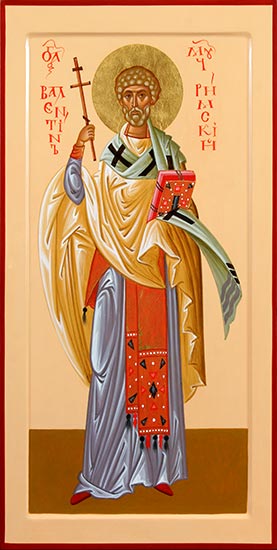 They all suffered in the time of the Emperor Claudius Flavius in Rome, in the year 269. Marinus and Martha were rich Persians, who had sold all their goods in Persia and gone with their sons to Rome to venerate the relics of the holy apostles and other martyrs. When the Emperor asked them why they had come such a distance, forsaking their household gods to seek the dead in Rome, they replied: "We are servants of Christ, and are come to venerate the holy apostles whose immortal souls are alive with God, that they may be our intercessors with Christ our God." Cyrinus was thrown into the Tiber, whence Marinus retrieved his body and buried it. The priest Valentine was committed to a General Asterius, whose task it was to urge him to deny Christ. But Valentine healed Asterius"s daughter, who had been blind for two years, by his prayers, and then baptised Asterius and his whole household. These all, in divers ways, received torture and death for Christ the Lord, who welcomed them into His immortal kingdom to rejoice eternally. They all suffered in the time of the Emperor Claudius Flavius in Rome, in the year 269. Marinus and Martha were rich Persians, who had sold all their goods in Persia and gone with their sons to Rome to venerate the relics of the holy apostles and other martyrs. When the Emperor asked them why they had come such a distance, forsaking their household gods to seek the dead in Rome, they replied: "We are servants of Christ, and are come to venerate the holy apostles whose immortal souls are alive with God, that they may be our intercessors with Christ our God." Cyrinus was thrown into the Tiber, whence Marinus retrieved his body and buried it. The priest Valentine was committed to a General Asterius, whose task it was to urge him to deny Christ. But Valentine healed Asterius"s daughter, who had been blind for two years, by his prayers, and then baptised Asterius and his whole household. These all, in divers ways, received torture and death for Christ the Lord, who welcomed them into His immortal kingdom to rejoice eternally.The Finding of the Relics of St Juliana the Virgin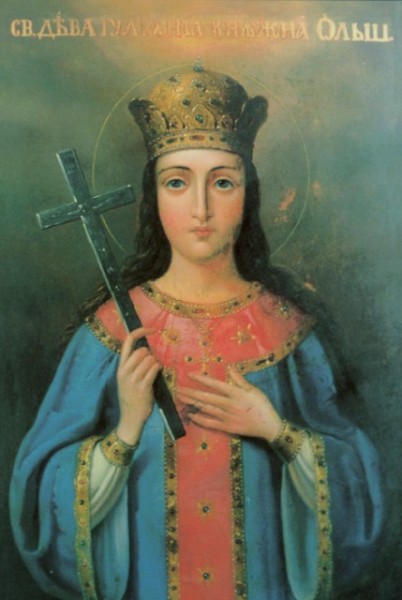 The daughter of a prince of Olshansk, Juliana died in about 1540, as a girl of sixteen. Two hundred years after her death, some men digging a grave near the great church in a monastery in Kiev found the relics of this holy virgin, whole and uncorrupt as though she had just fallen asleep. Many wonders were worked over these relics, and Juliana herself appeared several times to various people. The famous Peter Moghila was one of those who saw her. The daughter of a prince of Olshansk, Juliana died in about 1540, as a girl of sixteen. Two hundred years after her death, some men digging a grave near the great church in a monastery in Kiev found the relics of this holy virgin, whole and uncorrupt as though she had just fallen asleep. Many wonders were worked over these relics, and Juliana herself appeared several times to various people. The famous Peter Moghila was one of those who saw her.The Holy Martyr Lucy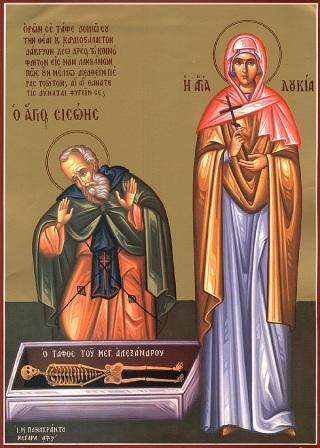 The barbarian King Austius made her a slave in Campania. He wanted to have her live with him, but she resisted. The king left her in peace, to live in asceticism. She brought the king to the Faith because, by her prayers, he was victorious in battle. Later, they both suffered for Christ in Rome, in about 300. The barbarian King Austius made her a slave in Campania. He wanted to have her live with him, but she resisted. The king left her in peace, to live in asceticism. She brought the king to the Faith because, by her prayers, he was victorious in battle. Later, they both suffered for Christ in Rome, in about 300.Martyrs Anthony, Lucian, Isidore, Dion, Diodorus, Cutonius, Arnosus, Capicus, Satyrus, and others
St. Cointus (Quintus) of Phrygia, confessor and wonderworker (283)The Holy Martyr Quintus hailed from Phrygia, a Roman province of Asia Monor, where since childhood he was brought up in Christian faith and piety. Having come to Neolida, he did many charitable acts and by prayer he healed those possessed by unclean spirits. The governor of the district Ruphus demanded the saint to offer pagan sacrifice to idols, but he fell down into a demonic fit and Saint Quintus healed him in the Name of Christ. The shaken-up and grateful Ruphus released Saint Quintus, having rewarded him.
The holy ascetic set off to Pergamum, but along the way he was seized by pagans from the city of Cimum, who began to torture him because he was a christian. But the Lord Himself intervened for the holy confessor: a strong earthquake occurred destroying the idolatrous temple. The frightened pagans stopped the torture, but left the saint in chains until the arrival of the new governor Klearchos. Klearchos gave orders to break the legs of Saint Quintus, but by the grace of God the saint was healed and after his confessor's act he lived 10 years more in the service of neighbour, working many miracles. He died in the year 283.
Martyrs Isaurus the Deacon, Innocent, Felix, Hermias, Basil, Peregrinus, Rufus, and Rufinus of Apollonia in Macedonia (283-284)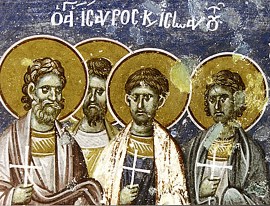 The Holy Martyrs Isaurios the Deacon, Innocent, Felix, Hermias, Basil, Peregrinus, – were Athenians, suffering for Christ in the Macedonian city of Apollonia under the emperor Numerian (283-284). Beheaded with them for believing in Christ were two city-governors – Ruphus and Ruphinus. The Holy Martyrs Isaurios the Deacon, Innocent, Felix, Hermias, Basil, Peregrinus, – were Athenians, suffering for Christ in the Macedonian city of Apollonia under the emperor Numerian (283-284). Beheaded with them for believing in Christ were two city-governors – Ruphus and Ruphinus.Synaxis of the Apostles Archippus, Philemon, and Onesimus
Martyr Epimachus
Martyr Alexander
Martyr Apollonius
New monk-martyr Cyril of Hilandar, Mt. Athos, who suffered at Thessalonica
|